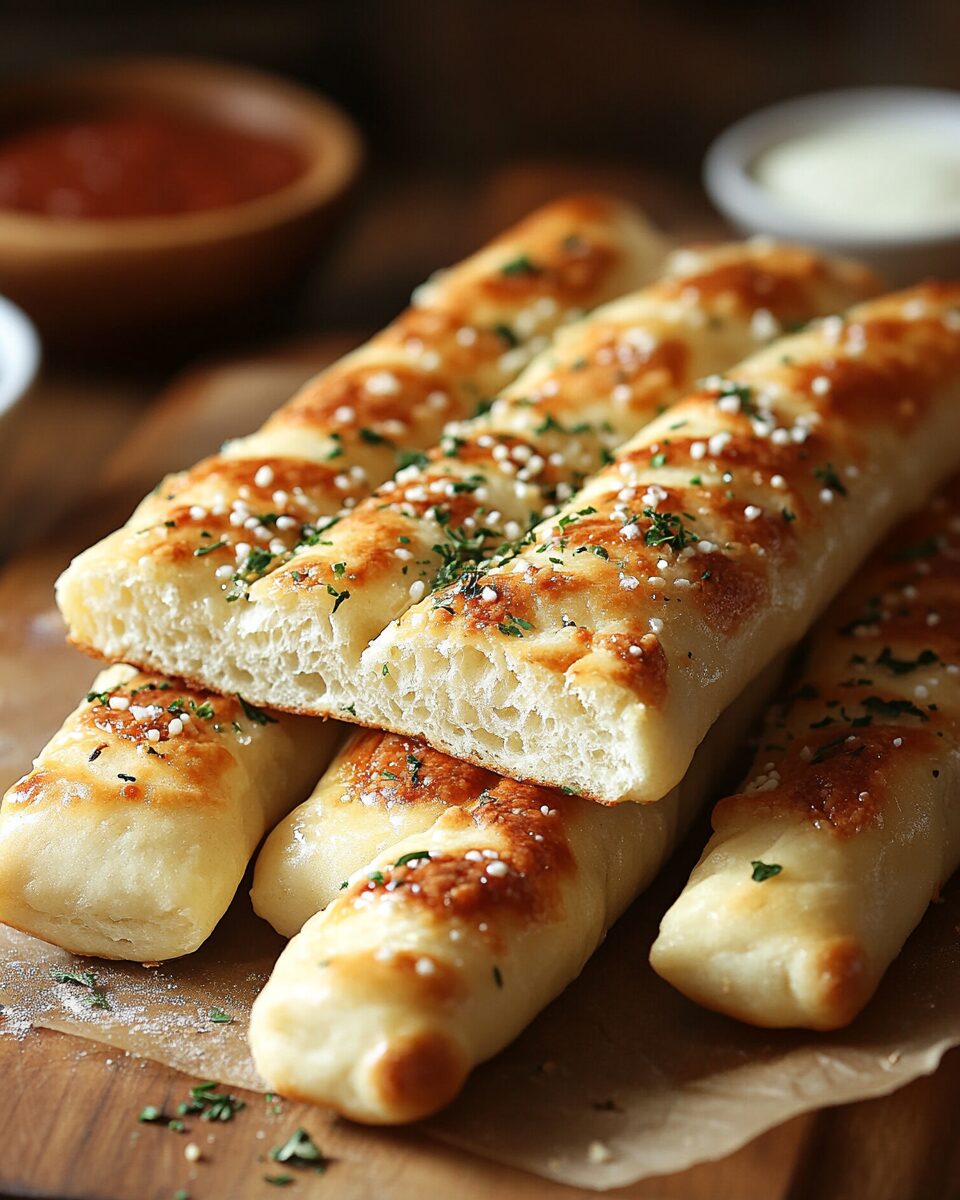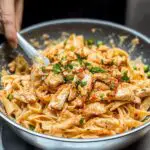These homemade breadsticks are soft, buttery, and perfectly seasoned, just like the ones served at Olive Garden. With a slightly chewy texture and garlic-butter topping, they’re an irresistible addition to any meal and surprisingly simple to make from scratch.
FULL RECIPE
Ingredients
- 1 ½ cups warm water (110°F)
- 2 tablespoons granulated sugar
- 1 tablespoon active dry yeast
- 2 tablespoons unsalted butter, softened
- 4 to 4 ½ cups all-purpose flour
- 2 teaspoons salt
Topping:
- 3 tablespoons unsalted butter, melted
- ½ teaspoon garlic powder
- ½ teaspoon salt
Directions
- In a large bowl, combine warm water and sugar; stir to dissolve.
- Sprinkle yeast over the water and let sit for 5–10 minutes, until foamy.
- Add softened butter, salt, and 2 cups of flour. Mix until well combined.
- Gradually add the remaining flour, ½ cup at a time, until the dough forms and is no longer sticky.
- Knead the dough on a floured surface for about 7 minutes, until smooth and elastic.
- Place the dough in a greased bowl, cover, and let rise in a warm place for 1 hour or until doubled in size.
- Punch down the dough and divide it into 12 equal pieces. Roll each piece into a 7-inch rope.
- Arrange breadsticks on a parchment-lined baking sheet. Cover and let rise for 30 minutes.
- Preheat oven to 400°F.
- Bake breadsticks for 12–14 minutes or until golden brown.
- While hot, brush with melted butter and sprinkle with garlic powder and salt mixture.
- Serve warm.
Nutritional Information
- Calories: 150
- Fat: 4g
- Saturated Fat: 2g
- Carbohydrates: 25g
- Sugar: 1g
- Protein: 3g
- Sodium: 230mg
- Fiber: 1g
History of Olive Garden Breadsticks
Olive Garden’s breadsticks have become a hallmark of the restaurant chain, symbolizing warmth, hospitality, and abundance. Since Olive Garden’s inception in 1982, these breadsticks have been served as a complimentary staple with each meal, earning iconic status among American diners. Inspired by traditional Italian baking techniques, these soft, garlic-butter topped breadsticks were developed to enhance the dining experience and quickly became a customer favorite. Their legacy continues today, and recreating them at home has become a popular endeavor for home cooks.
Why People Love Olive Garden Breadsticks
There’s a unique comfort that comes from biting into a freshly baked, warm breadstick. The soft, chewy interior combined with the buttery, garlicky exterior offers a savory, indulgent flavor that appeals to nearly every palate. They are versatile enough to be enjoyed on their own or as a perfect companion to soup, salad, or pasta dishes. Their consistency and nostalgic value only amplify their popularity.
Texture and Taste Profile
The breadsticks are soft, pillowy, and slightly chewy inside, with a golden-brown crust brushed in a savory garlic butter. The balance between the light sweetness in the dough and the savory butter topping gives them their unmistakable taste. They’re not overly dense, and the slight crispness on the outside contrasts beautifully with the tender inside.
Perfect Pairings for Breadsticks
These breadsticks pair exceptionally well with a variety of dishes. Classic Italian favorites like lasagna, fettuccine alfredo, or spaghetti and meatballs complement them well. They’re also perfect for dipping into marinara sauce, creamy alfredo, or soup. For a lighter option, serve them with a fresh garden salad drizzled with vinaigrette or Italian dressing.
Customizing the Breadsticks
While the original flavor is beloved, home bakers can easily customize these breadsticks. Adding herbs like oregano, basil, or rosemary to the butter topping can elevate the flavor. Cheese lovers can sprinkle grated parmesan or mozzarella before baking for a cheesy twist. For a spicy variation, adding crushed red pepper or a dash of cayenne to the butter mix gives it a kick.
Serving Suggestions
Serve breadsticks warm right out of the oven for the best flavor and texture. They can be placed in a bread basket lined with a clean kitchen towel to keep them warm at the table. For dinner parties or family meals, pair them with themed Italian nights or even as a warm appetizer before the main course.
Storing and Reheating Tips
To keep breadsticks fresh, store them in an airtight container or wrap them in foil. They stay good at room temperature for up to two days. To reheat, place them in a preheated oven at 350°F for 5–7 minutes, or until warm. For added moisture, wrap them in foil while reheating. Avoid microwaving as it may make them tough or chewy.
Making Ahead for Busy Schedules
These breadsticks can be prepared ahead of time by making the dough in advance. After the first rise, shape the dough into breadsticks, place them on a tray, cover, and refrigerate overnight. Let them come to room temperature before baking. Alternatively, you can freeze the shaped, unbaked sticks and thaw before baking as needed.
Using a Stand Mixer vs. Hand Kneading
While hand kneading is therapeutic and traditional, using a stand mixer with a dough hook attachment saves time and effort. It ensures a consistent dough texture and makes the process quicker, especially when baking large batches. However, hand kneading gives more control and connection to the process for those who enjoy tactile baking.
Tips for Perfect Results Every Time
Ensure the water used to activate the yeast is warm but not too hot—about 110°F is ideal. Over-flouring the dough can lead to dense breadsticks, so add flour gradually and stop once the dough is slightly tacky. Letting the dough rise in a warm, draft-free area will yield the best results. Always bake on the middle rack for even browning.
Butter and Garlic Topping Secrets
The topping is what sets these breadsticks apart. Melted butter is brushed on immediately after baking, allowing it to soak into the warm bread. Garlic powder and salt are then sprinkled on top to add flavor. For stronger flavor, some home bakers create a garlic butter paste that’s brushed both before and after baking.
Kids and Family-Friendly Appeal
Breadsticks are universally appealing and a great way to get kids involved in the kitchen. The shaping process is fun for little hands, and the finished product is almost always a hit at the dinner table. Their soft texture makes them suitable for all ages, from toddlers to grandparents.
Gluten-Free and Vegan Alternatives
For gluten-free versions, substitute with a gluten-free flour blend designed for yeast breads. To make the recipe vegan, swap out butter for a plant-based margarine and ensure the sugar used is vegan-friendly. These adaptations still produce satisfying, flavorful breadsticks that suit dietary needs.
Freezing for Long-Term Storage
Breadsticks can be frozen either before or after baking. To freeze before baking, shape them and place them on a baking sheet to freeze individually, then transfer to a freezer bag. To freeze baked breadsticks, let them cool completely and wrap tightly. Reheat in the oven straight from frozen for best results.
Cultural and Regional Influence
While inspired by Italian bread traditions, Olive Garden breadsticks reflect an American take on rustic Italian cuisine. They represent how Italian-American food culture has adapted to local tastes by emphasizing richness and comfort. This fusion has made them a staple not just in restaurants, but also in home kitchens across the country.
How to Make Them Look Restaurant-Quality
Uniform shaping is key to making breadsticks look professional. Use a kitchen scale to divide dough evenly and roll each piece to the same length. Brushing with butter at the right time gives them the glossy, golden look familiar from the restaurant. Baking on parchment paper also ensures a clean bottom with no sticking.
Health Considerations
While delicious, these breadsticks are best enjoyed in moderation. To make them a bit healthier, reduce the butter or use olive oil. You can also use whole wheat flour for added fiber, though the texture will be denser. Skipping the added salt on top can lower the sodium content without sacrificing too much flavor.
Adapting for Bread Machines
This recipe works well in a bread machine set to the dough cycle. Simply add the ingredients in the order recommended by your bread machine manual and let it knead and rise the dough. Once complete, remove the dough, shape, rise again, and bake as usual. This method saves time and simplifies the process for busy home cooks.
Hosting Events with Breadsticks
These breadsticks are ideal for parties, potlucks, and gatherings. They’re easy to transport and stay warm when wrapped properly. Serve them in a bread basket with dipping sauces for a buffet-style meal, or as part of a pasta bar. Their universal appeal ensures they’ll disappear quickly at any event.
Conclusion
Olive Garden-style breadsticks bring a little restaurant magic into the home kitchen. Their iconic flavor, comforting texture, and customizable nature make them a beloved addition to any meal. Whether served alongside a weeknight pasta dish or at a festive gathering, these breadsticks capture the heart of Italian-American comfort food. With a few simple ingredients and easy steps, anyone can recreate this crowd-pleasing classic and enjoy the warmth it brings to the table.






